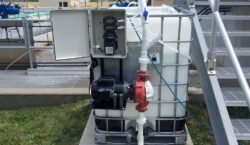
Biochar for Phosphate Removal from Water

Excess phosphate in water bodies can lead to eutrophication, causing algal blooms that reduce oxygen levels and threaten aquatic ecosystems. Removing phosphate from wastewater, agricultural runoff, and other point sources before they enter natural water systems is an essential strategy for preventing eutrophication. Biochar, a porous carbonaceous material produced by pyrolyzing biomass under oxygen-limited conditions, has shown promise as an adsorbent for removing phosphate from water due to its high surface area, surface charge characteristics, and pore structure.
How Biochar Adsorbs Phosphate
Biochar contains negatively charged functional groups on its surfaces, enabling electrostatic interactions with positively charged ions like ammonium (NH4+) and phosphate (H2PO4-, HPO42-). Phosphate can displace hydroxide (OH-) ions from biochar surfaces through ligand exchange reactions. Phosphate can also bind to positively charged sites on biochar through cation bridging by divalent cations like calcium (Ca2+). Additionally, physical processes like precipitation can retain phosphate in biochar’s porous structure. The abundance of pores of varying sizes provides considerable surface area and binding sites for phosphate adsorption.
Biochar properties like pH, surface area, surface charge density, and mineral content strongly influence its effectiveness at removing phosphate. High-temperature pyrolysis (>500°C) tends to produce biochars with alkaline pH, greater surface area and porosity, and higher negative surface charge density, enhancing phosphate adsorption capacity. Modifying biochar with solutions or coatings containing cations like calcium and magnesium before phosphate adsorption can augment cation bridges and increase uptake.
Comparing Biochar to Other Phosphate Adsorbents
Many substances demonstrate phosphate adsorption ability, but biochar possesses key advantages that position it as a promising adsorbent. Biochar’s high porosity and surface area provide abundant binding sites for phosphate while allowing faster sorption kinetics compared to denser minerals. It can be produced from inexpensive, locally available biomass feedstocks like crop residues and animal manures. Biochar production also generates bio-oil and syngas to supplement its economic viability. Further, spent biochar can be used as a soil amendment after phosphate saturation.
In contrast, other adsorbents have limitations for widespread use in removing phosphate from water. Activated alumina requires acidic conditions for optimal phosphate uptake, while biochar is effective across a more comprehensive pH range. Some industrial byproducts demonstrate good sorption capacity, but supplies are geographically limited. Ion exchange resins are expensive, and non-regenerable types require troublesome disposal. Costs for recycled adsorbents like blast furnace slag can also be prohibitive.
 Modifying and Using Biochar for Phosphate Removal
Modifying and Using Biochar for Phosphate Removal
Researchers continue investigating methods to enhance biochar for higher phosphate adsorption capacity. Oxidizing biochar using hydrogen peroxide or nitric acid introduces more oxygen-containing surface groups to provide additional bonding sites for phosphate. Activation with potassium hydroxide (KOH) expands pore sizes to augment surface area. Coating or mixing biochar with renewable biopolymers containing amine groups or waste products like red mud and lanthanum minerals creates more positively charged surfaces to bind more phosphate through ligand exchange.
Studies have examined phosphate removal from simulated wastewater, agricultural drainage, and eutrophic lake water using biochar from corn stover, sugarcane bagasse, coconut shells, and other feedstocks. Batch adsorption experiments provide information about sorption equilibria and kinetics to develop isotherms guiding biochar usage levels. Columns packed with biochar demonstrate its potential for free-flowing water treatment. Research results indicate high efficiency in phosphate removal across water conditions using unmodified and modified biochars derived from various biomaterials.
Ongoing investigations continue optimizing biochar production, tailoring, and implementation techniques for field deployment. Cost-benefit analyses accounting for different feedstocks, pyrolysis methods, modification reagents, and water conditions are needed to determine economic viability. Researchers recognize biochar use has tradeoffs – while appropriate for phosphate recovery, sorbed contaminants require proper disposal. Further inquiries regarding safe, sustainable integration of biochar-based phosphate removal into water treatment trains will support translating this technology from benchtop to full-scale remediation.
Conclusion
Using biochar provides a promising approach leveraging biomass waste valorization and circular economy principles to extract excess phosphate from waters. Additional research and development could soon enable scaled-up biochar phosphate sorption systems to augment traditional water treatment operations sustainably. Coupling biochar adsorption with recovery techniques like struvite precipitation allows phosphate recycling as fertilizer, with biochar regeneration and reuse providing carbon-negative environmental and economic benefits. With phosphorus itself a limited and nonrenewable resource, biochar technology could uniquely contribute to global food security and eutrophication control challenges.
 Modifying and Using Biochar for Phosphate Removal
Modifying and Using Biochar for Phosphate Removal